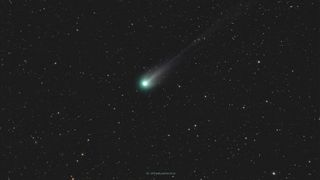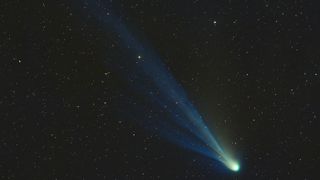'Devil Comet' 12P/Pons-Brooks is heading for the sun. Will it survive?
Comet 12P/Pons-Brooks will make its closest approach to the sun on April 21.

Comet 12P/Pons-Brooks, also dubbed the 'Devil Comet' has thrilled skywatchers in recent months with its impressive night sky display and sudden flare-ups in brightness. But as it approaches perihelion — its closest distance to the sun — on April 21, will it survive the encounter or be subjected to a fiery fate?
Well, there's good news and bad news.
The good news is that comet 12P/Pons-Brooks' survival chances are promising as it will give the sun a wide birth during perihelion, passing at about 72.6 million miles (116.8 million km), equivalent to three-quarters the Earth's distance from the sun.
Related: Amazing photos of 'horned' comet 12P/Pons-Brooks from around the world

Want to see comet 12P/Pons-Brooks for yourself? We recommend the Celestron Astro Fi 102 as the top pick in our best beginner's telescope guide.
The 'Devil Comet' orbits the sun approximately every 71 years, so this isn't its first encounter with our star. "It has apparently suffered no ill effects from previous visits to the sun and there does not appear to be any reason why anything will happen to it during its current apparition," meteorologist and skywatching columnist Joe Rao told Space.com.
The bad news for Northern Hemisphere skywatchers is that after its solar flyby, the comet will "fade very rapidly and largely become an object for Southern Hemisphere observers" commented Rao in a previous article.
"Comets generally "blossom" into peak brightness within several weeks of perihelion, and then as they move away from the warmth of the sun the volatile gases that are activated by the sun's heat and light will gradually subside." Rao continued.
Get the Space.com Newsletter
Breaking space news, the latest updates on rocket launches, skywatching events and more!
It's still not too late to see the 'Devil Comet' in the northern sky before it completely disappears into the sunset glow.
Rao estimates that comet 12P/Pons-Brooks will probably drop to 6th or 7th magnitude by the end of May and 8th or 9th magnitude by the end of June.
Those in the Southern Hemisphere have had to wait patiently for 12P/Pons-Brooks and can only now start to see it in the southern sky.

After perihelion on April 21, the celestial vagabond will continue its journey through the solar system before returning to our skies in 2095.
Not every comet that passes the sun is fortunate enough to continue its journey. When comets get closer to the sun than planet Mercury (36 million miles or 58 million kilometers), they are subjected to a far greater dose of heat which could shatter them.
Most comets spend the majority of their time in the outermost regions of the solar system experiencing temperatures around -300 to -400 degrees Fahrenheit ( -184 to -240 Celsius) range. When they come close to the sun, they can heat up very quickly, placing immense thermal stress on the comet.
"Fortunately, 12P/Pons-Brooks always stays just far enough away from the sun to avoid such a catastrophic scenario," said Rao.
Join our Space Forums to keep talking space on the latest missions, night sky and more! And if you have a news tip, correction or comment, let us know at: community@space.com.

Daisy Dobrijevic joined Space.com in February 2022 having previously worked for our sister publication All About Space magazine as a staff writer. Before joining us, Daisy completed an editorial internship with the BBC Sky at Night Magazine and worked at the National Space Centre in Leicester, U.K., where she enjoyed communicating space science to the public. In 2021, Daisy completed a PhD in plant physiology and also holds a Master's in Environmental Science, she is currently based in Nottingham, U.K. Daisy is passionate about all things space, with a penchant for solar activity and space weather. She has a strong interest in astrotourism and loves nothing more than a good northern lights chase!